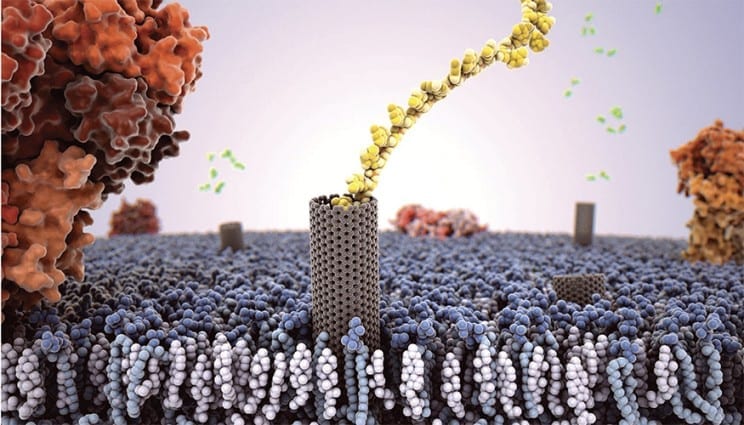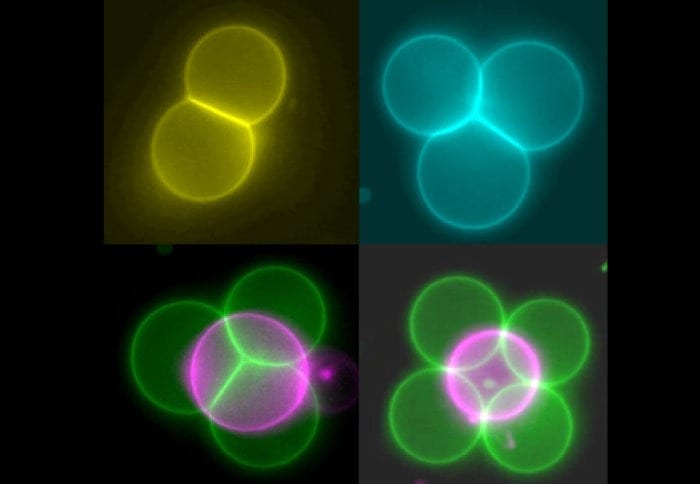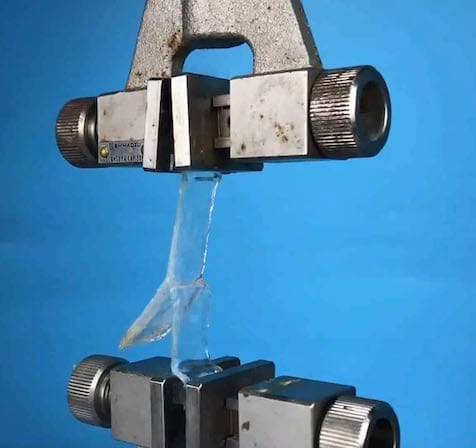
Proteins in lipid membranes are one of the fundamental building blocks of biological functionality. Lawrence Livermore researchers have figured out how to mimic their role using carbon nanotube porins.
Using high-speed, atomic force microscopy (HS-AFM), the team showed that a new type of biomimetic channel — carbon nanotube porins (CNTPs) — also is laterally mobile in supported lipid membranes, mirroring biological protein behavior.
The research opens the door to use CNTPs as models to study membrane protein physics, as well as versatile and mobile components for artificial cells and hybrid systems that combine biological cells and man-made components.
Lipid membranes represent one the fundamental components of the architecture of life because they provide a versatile matrix for a variety of membrane proteins that can perform a variety of tasks including molecular recognition and signal transduction, metabolite transport and membrane remodeling.
The 2D fluid nature of the lipid membrane not only allows it to adapt to a variety of shapes, but also permits membrane proteins to diffuse within this 2D plane, enabling many important biological processes.
“To understand the fundamental physics of protein motion in the lipid membrane, we needed an approach that would combine simple and robust membrane protein models with imaging and tracking approaches that can follow membrane motion on the relevant length and time scales,” said Yuliang Zhang, an LLNL postdoctoral researcher and lead author of a paper in the journal, Philosophical Transactions of the Royal Society B.
The team created simple and versatile artificial membrane pore equivalents — CNTPs —that are made of short segments of single-wall carbon nanotubes that can self-insert into the lipid membrane and form a transmembrane pore. These very simple objects show a wealth of behaviors similar to membrane protein pores: they can transport water, ions and protons across the membrane.
“We found that the CNTPS were able to reproduce another key property of membrane proteins — their ability to diffuse in the lipid membrane,” said Alex Noy, LLNL scientist and the principal investigator on the CNTP project. “High-speed AFM imaging can capture real-time dynamics of CNTP motion in the supported lipid bi-layer membrane.”
Zhang said the study demonstrates that the similarities between CNTPs and biological membrane pores include not only similar transport properties, but also the ability to move laterally in the membrane.
Learn more: Carbon nanotubes mimic biology
The Latest on: Carbon nanotube porins
[google_news title=”” keyword=”carbon nanotube porins” num_posts=”10″ blurb_length=”0″ show_thumb=”left”]
via Google News
The Latest on: Carbon nanotube porins
- Carbon credit standards approval extended to 98% of marketon May 2, 2024 at 1:04 am
LONDON, May 2 (Reuters) - Five of the world's largest carbon credit programmes have now been given initial approval by a body tasked with raising standards in the market for carbon offsets ...
- Carbon Offsets Newson April 30, 2024 at 5:00 pm
New revelations around a carbon deal in Malaysian Borneo criticized for its opacity have led to further calls for clarity and transparency about the project. Two international carbon credit project… ...
- Carbon Marketson April 28, 2024 at 8:18 am
Reuters, the news and media division of Thomson Reuters, is the world’s largest multimedia news provider, reaching billions of people worldwide every day. Reuters provides business, financial ...
- Rolls-Royce Spectre Gets Carbon-Fiber Makeover By Mansoryon April 24, 2024 at 5:00 pm
Mansory's extreme Spectre conversion includes visible carbon accents, massive vents, and 23-24 inch polished wheels. The interior of the Spectre is transformed with leather and carbon fiber ...
- Forests trap less carbon than before, EPA sayson April 23, 2024 at 10:35 am
The agency’s latest annual greenhouse gas inventory has mixed messages on the carbon-saving performance of forests and agricultural land. Forests in the U.S. may be losing some of their edge as ...
- Earth Day 2024: How to calculate your carbon footprint?on April 22, 2024 at 2:41 am
A carbon footprint represents the amount of carbon dioxide emitted because of how one lives one’s life. For instance, you can calculate the environmental impact of your transportation.
- 30 Countries with Carbon Tax in the Worldon April 18, 2024 at 10:21 am
The country implemented the carbon tax in 2021. Its carbon tax provides coverage for nitrogen oxides and carbon dioxide emissions. 21. Luxembourg Carbon Tax Price: NA ETS Price (2023): $96.30 per ...
- Carbon offsets too often don’t deliver. Inside the race to fix them.on April 17, 2024 at 11:16 am
in 2021. (Charlie Riedel/AP) They are marketed as a solution for companies and consumers looking to erase their carbon footprint, with promises that money spent on “offsets” will go to ...
- Our plans to tackle climate change with carbon storage don't add upon April 15, 2024 at 5:00 pm
Plans to tackle climate change by sucking carbon dioxide from the air and storing it underground are wildly unrealistic, according to a new analysis, calling into question our ability to meet ...
- The best carbon plate running shoes for your next PB attempton April 11, 2024 at 5:00 pm
Click here to subscribe. Whether or not you agree with them (and chances are, you do – especially if you've got your eye on a shiny new PB in 2024) carbon plate shoes have runners, from the ...
via Bing News










